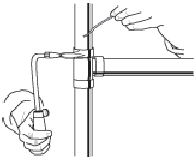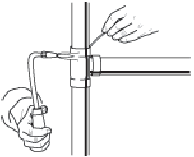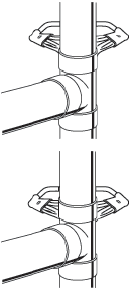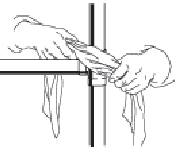| 7. |
开始铜焊时要先在连接部位加热。首选加热方法是采用氧乙炔火焰。小范围的加热有时也可以采用丙烷或其他气体。应该采用稍微缩小的火焰,在锥形蓝色焰心外带有轻微羽状边缘,火焰外部呈浅绿色。先加热管道,从距离管件边缘一英寸左右的地方开始加热。将火焰环绕管道顺着垂直于管道流向的方向上下移动对管道进行加热。特别重要的是要保持火焰连续移动,千万不要让火焰停留在某个部位持续加热,以避免烧穿管道。通常,可以利用焊剂作为加热管道时间多长的指标,在焊剂开始起泡或起作用时继续加热,直到焊剂变得平静并且透明如水时为止。焊剂将出现四种状态变化:
Brazing is started by applying heat to the
parts to be joined. The preferred method is by oxyacetylene flame.
Propane and other gases are sometimes used on smaller sizes. A slightly
reducing flame should be used, with a slight feather on the inner
blue cone; the outer portion of the flame, pale green. Heat the
tube first, beginning at about one inch from the edge of the fitting.
Sweep the flames around the tube in short strokes up and down at
right angles to the run of the tube. It is very important that the
flame be in continuous motion and should not be allowed to remain
on any one point to avoid burning through the tube. Generally, the
flux may be used as a guide as to how long to heat the tube, continuing
heating after the flux starts to bubble or work, and until the flux
becomes quiet and transparent, like clear water. The flux will pass
through four stages:
- 当温度达到100oC时水开始沸腾。
At 212oF (100oC) the
water boils of.
- 当温度达到315.6oC时焊剂变白,稍微起泡并开始起作用。
At 600oF (315.6oC)
the flux becomes white and slightly puffy and starts to work.
- 当温度达到426.7oC时铺满表面并且呈现乳白色状态。
At 800oF (426.7oC)
it lays against the surface and has a milky appearance.
- 当温度达到593.2oC时变得完全透明活跃,并且看起来像水一样。
At 1100oF (593.2oC)
it is completely clear and active and has the appearance of water.
|
| |
|
| 8. |
 现在将火焰转到管件的杯口底部。加热要均匀,将火焰从管件扫到管道直到管件上的焊剂变得平静为止。铸造管件要避免加热过度。 现在将火焰转到管件的杯口底部。加热要均匀,将火焰从管件扫到管道直到管件上的焊剂变得平静为止。铸造管件要避免加热过度。
Now switch the flame to the fitting at the
base of the cup. Heat uniformly, sweeping the flame from the fitting
to the tube until the flux on the fitting becomes quiet. Avoid excessive
heating of cast fittings. |
| |
|
| 9. |
当管道和管件上的焊剂都变成透明液体时,开始将火焰顺着连接轴线来回扫以对连接部件保持加热,特别要加热管件的杯口底部。火焰要保持移动状态,避免烧坏管道或管件。
When the flux appears liquid and transparent
on both the tube and the fitting, start sweeping the flame back and
forth along the axis of the joint to maintain heat on the parts to
be joined, especially toward the base of the cup of the fitting. The
flame must be kept moving to avoid burning the tube or the fitting. |
| |
|
| 10. |
 将铜焊线或条按在管道插入管件的杯口处。连接部位的温度应该高到能够融化铜焊合金。当融化的铜焊合金流入连接部位时将火焰从铜焊线或条上移开。当融化的铜焊合金流入连接部位时,通过来回移动火焰依次对管件和管道进行加热。当温度加热到一定程度,合金将流到管道外壁和管件插口内壁之间的空隙中,这种吸入作用是通过毛细吸引的自然力实现的。当连接部位充满合金后,环绕连接部位处完全可以看到一条连续的铜焊合金环带。一旦连接部位充满合金,立即停止操作。 将铜焊线或条按在管道插入管件的杯口处。连接部位的温度应该高到能够融化铜焊合金。当融化的铜焊合金流入连接部位时将火焰从铜焊线或条上移开。当融化的铜焊合金流入连接部位时,通过来回移动火焰依次对管件和管道进行加热。当温度加热到一定程度,合金将流到管道外壁和管件插口内壁之间的空隙中,这种吸入作用是通过毛细吸引的自然力实现的。当连接部位充满合金后,环绕连接部位处完全可以看到一条连续的铜焊合金环带。一旦连接部位充满合金,立即停止操作。
Apply the brazing wire or rod at a point where
the tube enters the socket of the fitting. The temperature of the
joint should be hot enough to melt the brazing alloy. Keep the flame
away from the rod or wire as it is fed into the joint. Keep both the
fitting and the tube heated by moving the flame back and forth from
one to the other as the alloy is drawn into the joint. When the proper
temperature is reached, the alloy will flow readily into the space
between the tube outer wall and the fitting socket, drawn in by the
natural force of capillary attraction. When the joint is filled, a
continuous fillet of brazing alloy will be visible completely around
the joint. Stop feeding as soon as the joint is filled. |
|
|
 注:对于通径DN25及以上的管道,很难一次性将整个连接部位加热到所需温度。比较好的常用方法是采用双火焰吹焰器来保持较大面积的所需温度。建议对整个管件进行适度预热。然后可以按照步骤7,8,9和10进行加热。如果一次性将整个管件加热到所需的温度遇到困难,那么当连接部位接近所需温度时,可以将合金集中在一个局部的区域。达到铜焊温度后,熔合合金流进连接部位,此时,将吹焰器移到邻近区域,并环绕连接部件继续进行操作。 注:对于通径DN25及以上的管道,很难一次性将整个连接部位加热到所需温度。比较好的常用方法是采用双火焰吹焰器来保持较大面积的所需温度。建议对整个管件进行适度预热。然后可以按照步骤7,8,9和10进行加热。如果一次性将整个管件加热到所需的温度遇到困难,那么当连接部位接近所需温度时,可以将合金集中在一个局部的区域。达到铜焊温度后,熔合合金流进连接部位,此时,将吹焰器移到邻近区域,并环绕连接部件继续进行操作。
NOTE: For tubing one inch and larger, it is difficult
to bring the whole joint up to heat at one time. It frequently will be found
desirable to use a double-tip torch to maintain the proper temperature over
the larger area. A mild pre-heating of the whole fitting is recommended.
The heating then can proceed as in steps 7, 8, 9, and 10. If difficulty
is encountered in getting the whole joint up to heat at one time, then when
the joint is nearly up to the desired temperature the alloy is concentrated
in a limited area. At the brazing temperature the alloy is fed into the
joint and the torch is then moved to an adjacent area and the operation
carried on progressively all around the joint.
水平连接 - 在进行水平连接时,最好是在相当于时钟5点钟指针位置处开始进行铜焊合金作业,然后移到7点钟指针位置,随后移到连接部位的顶部,确保铜焊作业位置交迭进行。
HORIZONTAL JOINTS - When making horizontal joints,
it is preferable to start applying the brazing alloy at the 5 o'clock position,
then move around to the 7 o'clock position and then move up the sides to
the top of the joint, making sure that the operations overlap.
 垂直连接
- 在进行垂直连接时,从何处开始进行铜焊作业则无关紧要。如果杯口的开口点朝下,应该小心操作避免过度加热管道。如果出现过度加热现象,则将吹焰器移开,让融合合金凝固。然后重新加热管件焊料杯口以吸入融合合金。 垂直连接
- 在进行垂直连接时,从何处开始进行铜焊作业则无关紧要。如果杯口的开口点朝下,应该小心操作避免过度加热管道。如果出现过度加热现象,则将吹焰器移开,让融合合金凝固。然后重新加热管件焊料杯口以吸入融合合金。
VERTICAL JOINTS - On vertical joints, it is immaterial
where the start is made. If the opening of the cup is pointed down, care
should be taken to avoid overheating the tube, as this may cause the alloy
to run down the tube. If this condition is encountered, take the heat away
and allow the alloy to set. Then reheat the solder cup of the fitting to
draw up the alloy.
 在铜焊合金固定后,清除连接部位的残留焊剂,因为这些残留焊剂具有腐蚀性,并且外观显得不整洁。应该采用热水或蒸汽和软布进行清理。锻造管件可能被冷却,但是在查擦拭之前,最好让铸造管件自然冷却到一定程度。在检查和进行压力测试之前所有焊剂必须清除。 在铜焊合金固定后,清除连接部位的残留焊剂,因为这些残留焊剂具有腐蚀性,并且外观显得不整洁。应该采用热水或蒸汽和软布进行清理。锻造管件可能被冷却,但是在查擦拭之前,最好让铸造管件自然冷却到一定程度。在检查和进行压力测试之前所有焊剂必须清除。
After the brazing alloy has set, remove residual
flux from the joint area as it is corrosive and presents an unclean appearance
and condition. Hot water or steam and a soft cloth should be used. Wrot
fittings may be chilled; however it is advisable to allow cast fittings
to cool naturally to some extent before applying a swab. All flux must be
removed before inspection and pressure testing.
故障原因
TROUBLE SPOTS
如果合金无法流动或有堵塞迹象,这表明金属表面有氧化现象,或者连接部位加热不足。如果在加热期间开始出现氧化,则表示焊剂太少,或者焊剂太稀薄。如果铜焊合金无法流进连接部位,并且倾向于流到所连接的两个部件外面,这表明这个连接部件加热过度,或者另一个加热不足,或者两个都是如此。在这些情况下,连接作业应该停止,并且拆开连接部件,重新清洗并且涂敷焊剂。
If the alloy fails to flow or has a tendency
to ball up, it indicates oxidation on the metal surfaces, or insufficient
heat on the parts to be joined. If work starts to oxidize during
heating, it indicates too little flux, or a flux of too thin consistency.
If the brazing alloy refuses to enter the joint and tends to flow
over the outside of either member of the joint, it indicates this
member is overheated, or the other is underheated, or both. In both
cases, operations should be stopped and the joints disassembled,
recleaned and fluxed.
|
|
 注:对于通径DN25及以上的管道,很难一次性将整个连接部位加热到所需温度。比较好的常用方法是采用双火焰吹焰器来保持较大面积的所需温度。建议对整个管件进行适度预热。然后可以按照步骤7,8,9和10进行加热。如果一次性将整个管件加热到所需的温度遇到困难,那么当连接部位接近所需温度时,可以将合金集中在一个局部的区域。达到铜焊温度后,熔合合金流进连接部位,此时,将吹焰器移到邻近区域,并环绕连接部件继续进行操作。
注:对于通径DN25及以上的管道,很难一次性将整个连接部位加热到所需温度。比较好的常用方法是采用双火焰吹焰器来保持较大面积的所需温度。建议对整个管件进行适度预热。然后可以按照步骤7,8,9和10进行加热。如果一次性将整个管件加热到所需的温度遇到困难,那么当连接部位接近所需温度时,可以将合金集中在一个局部的区域。达到铜焊温度后,熔合合金流进连接部位,此时,将吹焰器移到邻近区域,并环绕连接部件继续进行操作。 垂直连接
- 在进行垂直连接时,从何处开始进行铜焊作业则无关紧要。如果杯口的开口点朝下,应该小心操作避免过度加热管道。如果出现过度加热现象,则将吹焰器移开,让融合合金凝固。然后重新加热管件焊料杯口以吸入融合合金。
垂直连接
- 在进行垂直连接时,从何处开始进行铜焊作业则无关紧要。如果杯口的开口点朝下,应该小心操作避免过度加热管道。如果出现过度加热现象,则将吹焰器移开,让融合合金凝固。然后重新加热管件焊料杯口以吸入融合合金。 在铜焊合金固定后,清除连接部位的残留焊剂,因为这些残留焊剂具有腐蚀性,并且外观显得不整洁。应该采用热水或蒸汽和软布进行清理。锻造管件可能被冷却,但是在查擦拭之前,最好让铸造管件自然冷却到一定程度。在检查和进行压力测试之前所有焊剂必须清除。
在铜焊合金固定后,清除连接部位的残留焊剂,因为这些残留焊剂具有腐蚀性,并且外观显得不整洁。应该采用热水或蒸汽和软布进行清理。锻造管件可能被冷却,但是在查擦拭之前,最好让铸造管件自然冷却到一定程度。在检查和进行压力测试之前所有焊剂必须清除。